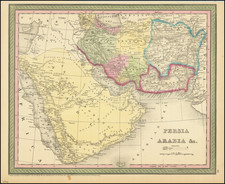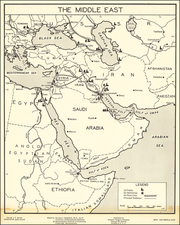Tracking Sir Lewis Pelly's Journey to Riyadh in in 1865
Detailed map of a portion of the Arabian peninsula, showing the route of Sir Lewis Pelly's overland route from Bushehr in Iran to Kuwait, then overland south thru the Shug, Wurrea, Sumaan, Dahna and Ormah districts to Seddos and Riyadh, for an important diplomatic mission to meet with Faisal bin Turki Al Saud (1785-1865), the 7th head of the house of Faud. On his return journey to Iran, Pelly travelled east to the El Ahsa District, Al Uqayr and then by boat via Bahrein to Bushehr.
The map was prepared to illustrate Lieutenant Colonel Pelly's Report on a Journey to Riyadh in Central Arabia, presented to the Royal Geographical Society and published in 1865.
Lieutenant General Sir Lewis Pelly in Arabia
Sir Lewis Pelly, was an influential figure during the British imperial age. In 1860, Pelly undertook a remarkable journey, traveling overland on horseback, mostly in uniform, from Tehran to Calcutta. This venture captured the attention of Sir Bartle Frere, a leading advocate of the 1860s Forward Policy for British India. Impressed by Pelly's audacity, Frere became a guiding force and patron in his career.
In May 1861, Pelly was an integral part of the expedition that placed Bahrain under British sphere of influence, shifting it away from Persia. His influence in the Arabian region deepened when he was appointed the political agent and consul at Zanzibar. During this tenure, he played a significant role in resolving the dispute between the Sultanate of Zanzibar and the Sultanate of Oman, known as the Canning Award. Despite the political tug of war that ensued after the power shift in Oman, Pelly sided with Majid bin Said of Zanzibar, consolidating his influence and Britain's position in the region.
Pelly's services were again requisitioned in Persia, where he served as the political resident from 1862 to 1872. During this time, he became an advocate for the Persian Gulf Telegraph Cable, contributing to its planning and surveying potential routes, highlighting his multi-faceted role in shaping the region's infrastructural advancements.
Perhaps one of his most significant diplomatic feats was his official visit to Riyadh in 1865. Meeting with the ruler of the Second Saudi State, Faisal bin Turki, Pelly showcased his intent to foster trade and strengthen ties. His journey to Nejd and the associated map he produced became instrumental in understanding the region.
Amid the political tumult of the Qatari–Bahraini War in 1867, Pelly once again displayed his diplomatic prowess. Demonstrating British power, he sailed to Bahrain and was central in deposing Muhammad bin Khalifa Al Khalifa. This strategic move ensured Ali bin Khalifa Al Khalifa's ascension as the ruler of Bahrain. Subsequently, Pelly's actions led to the signing of a treaty recognizing Qatar's independence, further cementing Britain's influence in the region.









![(First state!) [Arabia and Persian Gulf] Tabula Asiae VI](https://storage.googleapis.com/raremaps/img/small/94608.jpg)
![[ Arabian Peninsula ] Sexta Asie Tabula](https://storage.googleapis.com/raremaps/img/small/80372.jpg)
![[Empire of Alexander The Great] Antiquor? Imperiorum Tabula in qua prae caeteris, Macendonia seu Alexandri Magni et Expeditiones exarantur . . .](https://storage.googleapis.com/raremaps/img/small/70608.jpg)

![[Arabia] Tabula Asiae VI](https://storage.googleapis.com/raremaps/img/small/87151.jpg)
